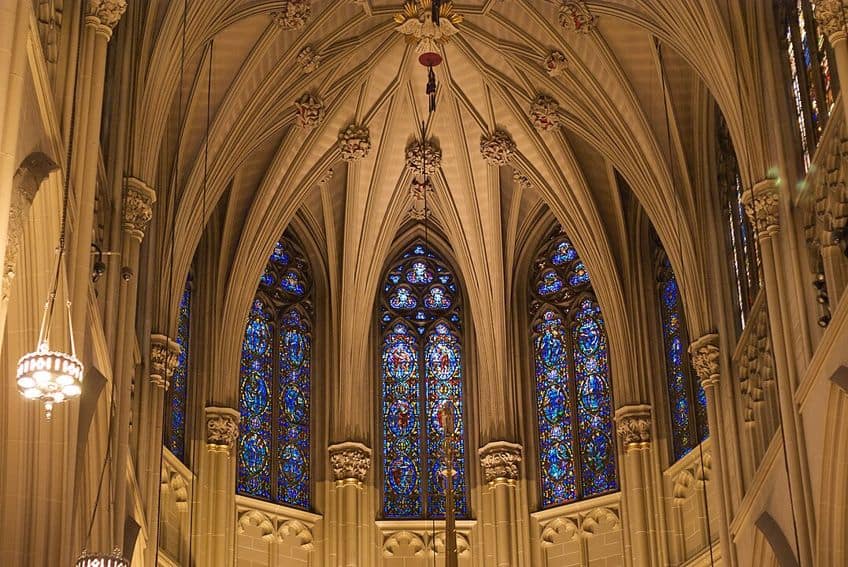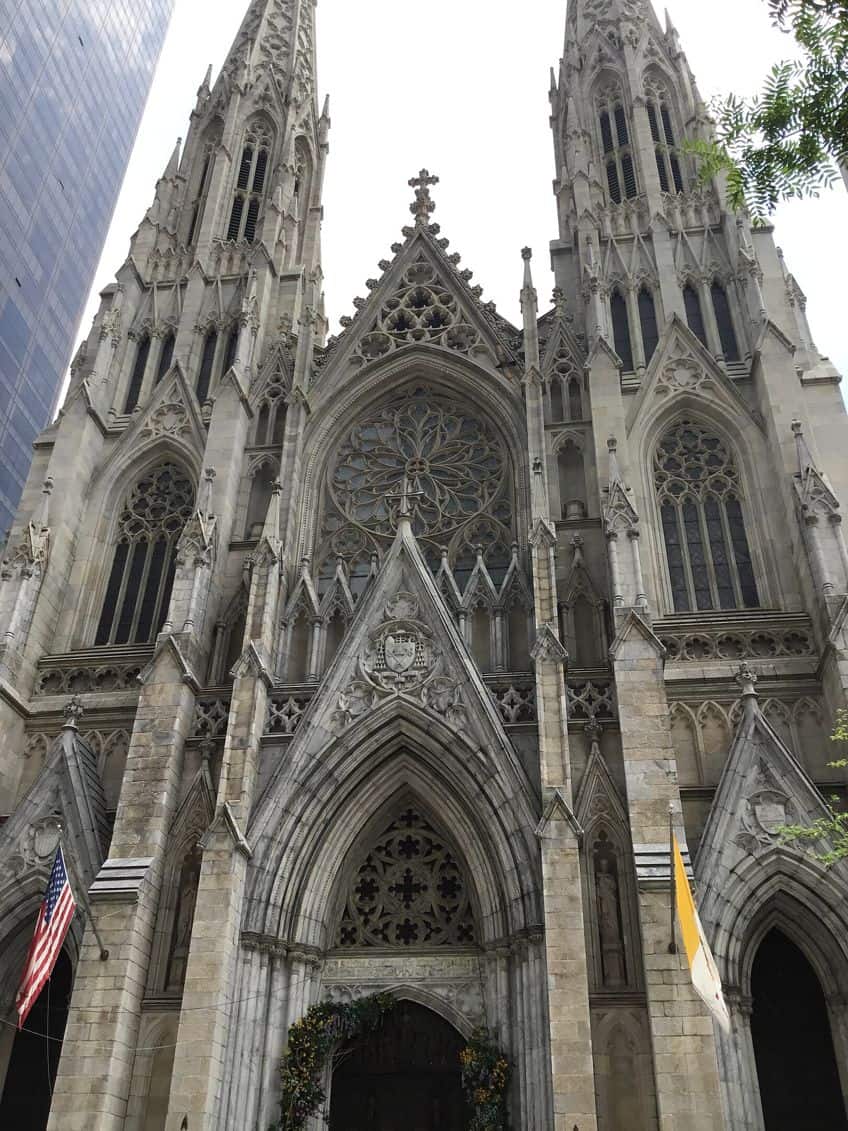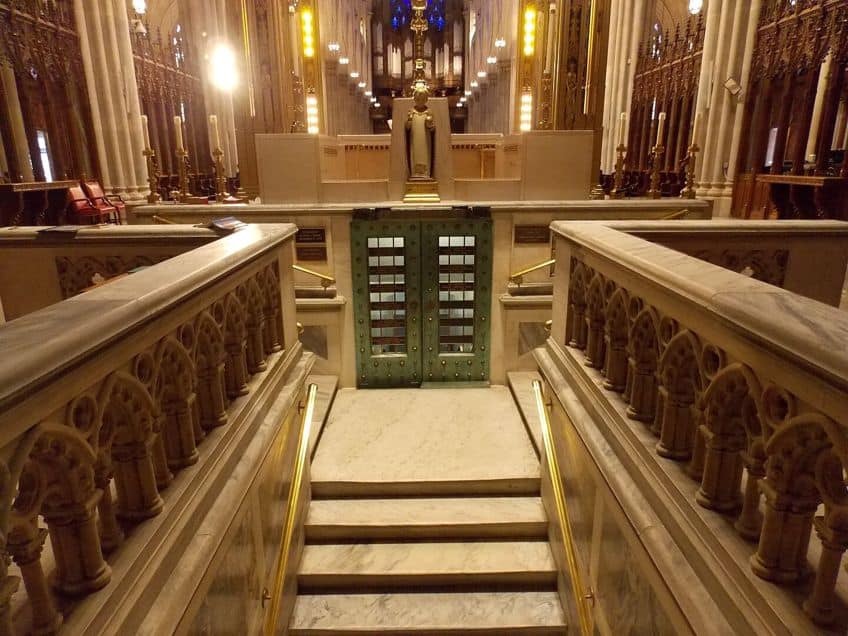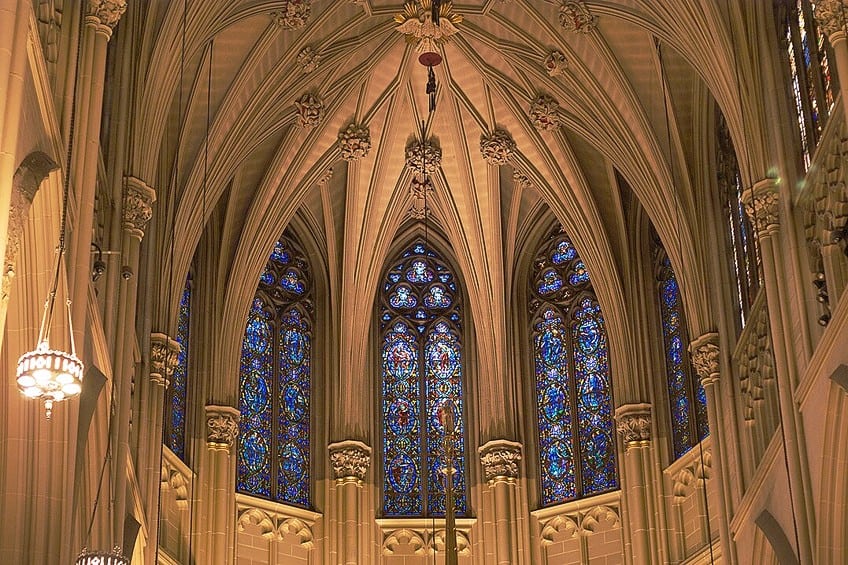St Patrick’s Cathedral – A Landmark of Elegance
St Patrick’s Cathedral, also known as San Patricio Church, is a Gothic Revival church in New York City, and is the oldest of its kind in the entirety of the United States. This cathedral has been one of the most important Catholic structures in the country, and so we are going to have a look at its general characteristics, history, and some of the more interesting aspects of this particular church today. Keep reading to learn more about St Patrick’s Cathedral!
Contents
A Look at St Patrick’s Cathedral
| Architect | James Renwick Jr. (1818 – 1895) |
| Date Constructed | 1858 – 1879 |
| Function | Cathedral |
| Location | New York City, United States |
St Patrick’s Cathedral is located in Manhattan in New York City, and it’s large enough that it manages to take up an entire block in the city. For those who are unfamiliar with the size of a standard New York City block, this is not a small feat (but we will look at the dimensions of this structure in time). The cathedral is also situated in a rather famous portion of the city as it is directly across the road from the Olympic Tower, beside the International Building of Rockefeller Center and the Lotte New York Palace Hotel. It is an important New York City landmark, and it has earned its place as such over generations.

The church has also been considered to be an important part of the overall architecture of New York City for many years, and it was once a notable part of the skyline (but the advent of skyscrapers in the 20th century tended to put structures like this to shame in terms of height). However, even though St Patrick’s Cathedral is no longer one of the tallest buildings in the city, it has remained through thick and thin as a popular sight to see and visit for more secular individuals while retaining its religious use through the years.
St Patrick’s Construction Materials
St Patrick’s Cathedral’s foundation was constructed using blue gneiss granite and cement, and once it was laid down, the façade and interior columns were made using Dix Island granite. This particular granite had to be shipped in from Maine, but thanks to the gorgeous presentation of the church as a whole, this was definitely worth the expense it would have accrued.
In juxtaposition, the exterior of St Patrick’s Cathedral is covered in marble that was mined in Massachusetts and New York State.
The vast majority of the primary portions of the cathedral were constructed using Tuckahoe marble. However, thanks to the expense of marble, it is generally not used for an entire structure, so behind the marble, rough masonry can be found that combines brick and stone.
St Patrick’s Cathedral Architecture Characteristics
St Patrick’s Cathedral is not a small structure, as has already been hinted at, but what kind of dimensions are we looking at here? Well, the church is 101 m (or 332 ft) in length. This is a single meter longer than the standard short-distance running length for Olympic races. It is not an insignificant size. However, that’s just the length. The width is 53 m (or 174 ft), and so even the width of this church structure is rather significant. It may not be the longest or widest church in the world, but it is still a massive church structure.
The other major dimension at play here is the height of the building.
Now, the roof height is not the most impressive thing, and most do not even consider it. Instead, St Patrick’s Cathedral contains two spires in the front, and these spires measure 100.4 m (or 329.5 ft) high, which makes it only about half a meter shorter than the length of the structure. So, it’s nearly as tall as it is long. We have thus far only discussed the dimensions of this building, but what about the architectural style? Well, the San Patricio Church, which was predominantly designed by James Renwick Jr., decided to adopt a Gothic Revival style for this structure. The original Gothic style, which is known for its use of pointed arches, flying buttresses, and magnificent height, ended centuries before the construction of this building had begun, but the Neo-Gothic style had been in vogue for a while.

So, this Gothic Revival church was inspired by a combination of different Gothic styles from across Europe. This style had been prevalent in many countries, and so when the architect was designing this structure, he borrowed from French, English, and German Gothic traditions. This means that St Patrick’s Cathedral architecture is something of an amalgamation, but an amalgamation of forms from within a fairly unified style. Changes were made to the more traditional Gothic structure, such as a general reduction in the overall height and the prevalence of flying buttresses. But one thing that was not changed was the Gothic dedication to windows. Windows were very important in the Medieval Gothic style because they allowed for far greater light levels to filter through and into the building.
So, St Patrick’s Cathedral makes exquisite use of windows.
There are a whopping 103 windows in the building, and while they are not all stained glass, 57 of them are. Those stained-glass windows are then further subdivided into two different types of stained-glass design. 37 stained-glass windows depict various scenes and narratives from the Christian Bible while the other 20 stained-glass windows are instead comprised of geometric designs.

Stained glass has often served as an important aspect of many Christian structures, and it is adopted in full force in St Patrick’s Cathedral too. The building, while it has a lighter tone than some of the European Gothic cathedrals, is a strong addition to the Gothic tradition, but it also made use of some other rather innovative techniques that were very much not Gothic in design. The most impressive and fascinating of these is St Patrick’s Cathedral’s geothermal regulation system.
St Patrick’s Cathedral’s Geothermal System
Buildings can get hot. Buildings can get cold. This is an irritating fact of life, and it can be very difficult, without the use of expensive air conditioning, to regulate the temperature of a building. The designers of St Patrick’s Cathedral came up with an elegant solution. Outside the building, if one were to pay close attention, one could discover the ten manholes that lead to the church’s subterranean geothermal regulation system. The idea was that because the building could accommodate nearly 20,000 people in various seated and unseated positions, there would be a need to ensure that this group of people did not either boil or freeze within the church.
So, the sophisticated geothermal system is made up of ten separate wells that are 670 m (or 2,200 ft) deep, and these wells allow for hot or cold air to be pushed into different sections of the cathedral based on the needs of the cathedral at any particular point in time.
A system like this is not exactly usual for your standard church, but it’s likely a very happily accepted attribute of the building. No one wants to get too hot. No one enjoys sitting in sweltering, sweat-inducing heat and no one likes shivering, especially while trying to attend a church service. So, St Patrick’s Cathedral’s solution is an interesting one that allows it to keep the building at a nice temperature all year round.
St Patrick’s Cathedral’s Crypt and Its Occupants
One of the primary features of St Patrick’s Cathedral is the crypt beneath the building. This crypt has been used to house some of the most prominent Catholic leaders from the city, and all of the previous Archbishops of New York can be found in this crypt. From John Joseph Hughes (who was interred in 1883) to Edward Michael Egan (who was interred in 2015). However, other than the Archbishops of New York, there are also others buried within the walls, although each of those individuals was generally buried there because they were notable in some way within the Catholic faith in that region.
The crypt itself can only be accessed through a set of doors situated behind the church’s high altar.
You then follow a stone staircase downwards and pass through another door into the crypt itself. Each of those who are interred in the crypt has its own sections with large bronze letters stating who they all are. The crypt is also not all that large at only 6.4 m (or 21 ft) in length, 3 m (or 10 ft) in height, and 3 m (or 10 ft) in width.

This comparatively small size still allows it to accommodate anywhere from 24 to 42 people within its walls. Despite the crypt’s comparatively small size, it can accommodate a good few people before it becomes full. This means that there may come a day when the Archbishops of New York need a new location for their crypt, but until that day, the crypt in St Patrick’s Cathedral will serve well in this role.
A Brief History of St Patrick’s Cathedral
So, when was the St Patrick’s Cathedral built? Well, the structure needed to be built because the original Diocese of New York, which was founded in 1808, had grown. The United States has always been a country that was founded on Protestant principles and by Protestant people, but Catholics were always in the country and their population started to grow.
There was a smaller church, St. Peter’s Church, but it had become far too small.
The small size of the church that had been used, combined with the ever-increasing population, meant that a solution based on extensive forethought needed to be taken into account. This could not be a small church that was now big enough for the present population, it had to take into account the future of the Catholic people within the region. There needed to be a whole lot more space, and so a location was decided, and a church would soon be built.
The Early History of St Patrick’s Cathedral
The earliest days of St Patrick’s Cathedral were in the early 1850s as the decision to construct a new cathedral had been decided. The Archbishop of New York at the time, John Joseph Hughes, appointed a new architectural firm to the job, and the primary architect from this firm to work on the structure was James Renwick Jr. He didn’t immediately design the structure and instead spent three years in Europe to survey Catholic cathedrals throughout the continent.

He was especially influenced by the then-unfinished Cologne Cathedral in Germany, and because of this particular influence, he actually planned a far larger church than the one that was eventually constructed. However, the architect and the influences had been determined, and so it was finally time for construction to get underway.
The Construction of St Patrick’s Cathedral
The cornerstone for St Patrick’s Cathedral was laid in 1858 by the Archbishop of New York, and so construction officially started on the building. This event was actually watched by over 100,000 spectators, but the exact location of this first stone or where the people surveyed the site is not entirely known any longer. Either way, construction had finally started. Construction lasted for two years after that. The large stone slabs that comprised much of the foundation needed to be laid and excavations needed to be done. However, the walls had only reached an average height of 3.7 m (0r 12 ft) before the church’s budget entirely ran out. This led the archbishop to suspend all construction work as they searched for new avenues of funding for the building.
This only lasted a year though, but not because construction resumed. Instead, this was because the American Civil War broke out in 1861.
Hughes, the archbishop at the time, never got to see the completion of the cathedral as he passed away in 1864, but his successor determined a way to make up the additional cash needed to resume construction. In 1877, the incomplete cathedral was opened to the public, and a fundraising event was started. This fundraising event would be a month-long, and it saw some fantastic attendance. The first three weeks saw an average daily attendance of up to 11,000 people. It did not manage to attain its full desired budget, but it did make more than enough to resume construction.
So, construction was officially restarted and finally came to an end in 1879. St Patrick’s Cathedral was officially completed, and it has remained as a church to this day. It only took a good few decades and an entire war, but the cathedral managed to survive its way through and emerged on the other side as one of the most important pieces of Neo-Gothic architecture in the United States.
The Many Threats St Patrick’s Cathedral Has Received
St Patrick’s Cathedral has served as a Catholic cathedral ever since it was completed, but this does not mean that it has lived a simple life ever since. Instead, the building has been subject to a number of attacks. There was a 1914 bomb attack that left part of the floor destroyed, a 1915 attempted bombing, and both a 1951 and 1953 series of bomb threats. The building has clearly been a target for certain people. The most recent of these kinds of threats was a 2019 arson attempt in which, only two days after the famous Notre-Dame de Paris fire in France, a man entered the building with flammable materials and attempted to burn the structure to the ground. He was also a philosophy professor but suffered from schizophrenia.
Either way, St Patrick’s Cathedral has clearly served as a location for those who would do harm to a Catholic church.

However, despite the repeated attacks on this gorgeous Neo-Gothic structure, it still stands to this day and will likely continue to stand well into the future. It has had a long history behind it, but if a funding issue couldn’t stop the construction of this building, then a few people attempting to destroy the building shouldn’t be much of a challenge either.
We have come to the end of our discussion about St Patrick’s Cathedral. We have examined some of the characteristics of this famous American Catholic church, its technological alterations to standard Gothic design, its crypt, and its history. It is an incredibly important Catholic church within the United States and a gorgeous example of Neo-Gothic architecture. So, all that’s left for us to say is that we wish you a great day/week/month ahead!
Frequently Asked Questions
When Was the St Patrick’s Cathedral Built?
St Patrick’s Cathedral was constructed between 1858 and 1879. It was constructed in this era because the number of Catholics in New York City had quickly grown over the years and there needed to be a place for them to worship. The United States has generally been built on Protestant ideals, and there was actually only one Catholic signatory on the Declaration of Independence, but the relationship between the Catholic and Protestant churches has not been too fraught in the United States. So, a Catholic cathedral could, at least, be constructed in this region without any issues for those who adhere to the denomination’s doctrines.
Which Architectural Style Does St Patrick’s Cathedral Use?
St Patrick’s Cathedral makes use of a Neo-Gothic style that was influenced by the traditional Gothic architectural traditions of England, France, and Germany. These countries exhibited some of the most prominent instances of Gothic architecture, and so drawing from them was a fantastic decision. St Patrick’s Cathedral architecture has remained one of the most striking in the United States, as it appears to be the kind of structure that would easily fit in amongst the Gothic cathedrals of Europe.
What Are St Patrick’s Cathedral Architecture Characteristics?
St Patrick’s Cathedral adopted a Neo-Gothic style, and for that reason, it used many of the most common features of Gothic architecture. These can be seen in the use of attributes such as the pointed arches and spires that the cathedral made use of, the extensive array of stained-glass windows, and the flying buttresses that aided in the extension of the building’s overall height. These architectural features are commonly found in Gothic structures, and St Patrick’s Cathedral emulates those forms incredibly well.
Justin van Huyssteen is a writer, academic, and educator from Cape Town, South Africa. He holds a master’s degree in Theory of Literature. His primary focus in this field is the analysis of artistic objects through a number of theoretical lenses. His predominant theoretical areas of interest include narratology and critical theory in general, with a particular focus on animal studies. Other than academia, he is a novelist, game reviewer, and freelance writer. Justin’s preferred architectural movements include the more modern and postmodern types of architecture, such as Bauhaus, Art Nouveau, Art Deco, Brutalist, and Futurist varieties like sustainable architecture. Justin is working for artfilemagazine as an author and content writer since 2022. He is responsible for all blog posts about architecture.
Learn more about Justin van Huyssteen and about us.
Cite this Article
Justin, van Huyssteen, “St Patrick’s Cathedral – A Landmark of Elegance.” artfilemagazine – Your Online Art Source. November 2, 2023. URL: https://artfilemagazine.com/st-patricks-cathedral/
van Huyssteen, J. (2023, 2 November). St Patrick’s Cathedral – A Landmark of Elegance. artfilemagazine – Your Online Art Source. https://artfilemagazine.com/st-patricks-cathedral/
van Huyssteen, Justin. “St Patrick’s Cathedral – A Landmark of Elegance.” artfilemagazine – Your Online Art Source, November 2, 2023. https://artfilemagazine.com/st-patricks-cathedral/.



